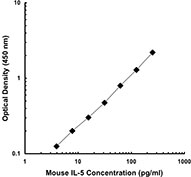- Regulatory Status
- RUO
- Other Names
- sCD25 (IL-2Ra), 4-1BB, CD86 (B7.2), TGF-β1 (Free Active Form), CTLA-4, PD-L1, PD-1, Tim-3, LAG-3, Galectin-9
- Ave. Rating
- Submit a Review
- Product Citations
- publications
The LEGENDplex™ HU Immune Checkpoint Panel 1 (12-plex) is a bead-based multiplex assay panel, using fluorescence-encoded beads suitable for use on various flow cytometers. It allows for simultaneous quantification of 12 key immune checkpoint proteins: sCD25 (IL-2Ra), 4-1BB, sCD27, B7.2 (CD86), Free Active TGF-β1, CTLA-4, PD-L1, PD-L2, PD-1, Tim-3, LAG-3, and Galectin-9. This assay panel provides higher detection sensitivity and broader dynamic range than traditional ELISA methods. The panel has been validated for use on cell culture supernatant, serum, and plasma samples.
The LEGENDplex™ HU Immune Checkpoint Panel 1 is configured as shown below depending on sample types and required dilutions:
|
Catalog No. |
Plex Size |
Targets |
Recommended Sample Type |
Recommended Dilution Factor |
|
740866 740867 |
12-plex |
sCD25 (IL-2Ra), 4-1BB, sCD27, B7.2 (CD86), Free Active TGF-β1, CTLA-4, PD-L1, PD-L2, PD-1, Tim-3, LAG-3, Galectin-9 |
Tissue Culture |
Varies |
|
740961 740962 |
10-plex |
sCD25 (IL-2Ra), 4-1BB, B7.2 (CD86), Free Active TGF-β1, CTLA-4, PD-L1, PD-1, Tim-3, LAG-3, Galectin-9 |
Serum, Plasma |
2 |
|
740963 740964 |
2-plex |
sCD27, PD-L2 |
Serum, Plasma |
100 |
The LEGENDplex™ HU Immune Checkpoint Panel 1 is designed to allow flexible customization within the panel. Please visit www.biolegend.com/legendplex for more information on how to mix and match within the panel.
This assay is for research use only.
Kit Contents
- Kit Contents
-
- Setup Beads: PE Beads
- Setup Beads: Raw Beads
- Capture Beads
- Detection Antibodies
- Standard Cocktail, Lyophilized
- SA-PE
- Assay Buffer
- Matrix A1, Lyophilized
- Wash Buffer, 20X
- Plate Sealers
- V-bottom Plate
Product Details
- Verified Reactivity
- Human
- Application
-
Multiplex
Learn more about LEGENDplex™ at biolegend.com/legendplex
Download the LEGENDplex™ software here. - Materials Not Included
-
- Flow Cytometer
- Pipettes and Tips
- Reagent Reservoirs for Multichannel Pipettes
- Polypropylene Microfuge Tubes
- Micro FACS tubes (if the flow cytometer does not contain an autosampler)
- Vortex Mixer
- Sonicator
- Aluminum Foil
- Absorbent Pads or Paper Towels
- Plate Shaker
- Tabletop Centrifuges
- A Vacuum Filtration Unit and a Vacuum Source (if using filter plates)
Antigen Details
- Biology Area
- Cancer Biomarkers, Immunology
- Molecular Family
- Cytokines/Chemokines, Soluble Receptors
- Gene ID
- 3559 View all products for this Gene ID 3604 View all products for this Gene ID 939 View all products for this Gene ID 942 View all products for this Gene ID 7040 View all products for this Gene ID 1493 View all products for this Gene ID 29126 View all products for this Gene ID 5133 View all products for this Gene ID 84868 View all products for this Gene ID 3902 View all products for this Gene ID
Related Pages & Pathways
Pages
Related FAQs
- If I don't have a vacuum, how do I remove the liquid from my plate?
-
If you do not have a vacuum, the assay should be run in a V-bottom plate. After centrifugation using a swinging-bucket rotor with a plate adaptor, you can remove the liquid by flicking the plate quickly, dumping the contents into a sink, and patting it dry carefully on a stack of clean paper towels without losing the beads. Alternatively, you can remove the liquid by using a pipette.
- Should I perform the assay with the filter plates or with V-bottom plates?
-
Filter plates or V-bottom plates have been included in some kits for your convenience. A vacuum filtration unit is required to work with the filter plates. However, if you don’t have access to a vacuum manifold or if you prefer, then you can use the V-bottom plates and follow the recommended assay protocols for the type of plates you choose. All plates should be made from low binding polypropylene. Polystyrene ELISA or cell culture plates should not be used.
- After I finish the staining process, how long can I wait before reading my LEGENDplex™ samples?
-
The samples can be kept overnight at 4°C while being protected from exposure to light and be read the next day. There may be a decrease in signal, but overall, the assay results should not be affected. Storing the samples for extended periods of time is not recommended, as it could lead to further reductions in signal.
- What is the shelf life of LEGENDplex™ kits?
-
LEGENDplex™ kits are guaranteed for 6 months from the date of receipt, but may have a shelf life of up to 2 years from the date of manufacture.
- Is special software required for data analysis?
-
Typically flow cytometers generate output files in FCS format (e.g. FCS 2.0, 3.0, or 3.1) and in some cases in list mode file format (LMD). Other software may be available to analyze FCS files. Data generated using LEGENDplex™ kits can be analyzed using the freely available LEGENDplex™ data analysis software. Please check our website for the most updated versions of the software.

 Login / Register
Login / Register 












Follow Us